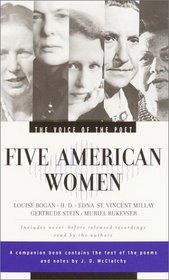Search -
The Voice of the Poet : Five American Women : Gertrude Stein, Edna St. Vincent Millay, H.D., Louise Bogan & Muriel Rukeyser
The Voice of the Poet Five American Women Gertrude Stein Edna St Vincent Millay HD Louise Bogan Muriel Rukeyser
An Anthology of Women Poets that includes: Gertrude Stein, Edna St. Vincent Millay, H.D., Louise Bogen, and Muriel Rukeyser. — Each audio production is accompanied by a book containing the text of the poems and a commentary by J.D. McClatchy. — Gertrude Stein (1874-1946) After attending Radcliffe College, Gertrude Stein lived abroad,... more »
An Anthology of Women Poets that includes: Gertrude Stein, Edna St. Vincent Millay, H.D., Louise Bogen, and Muriel Rukeyser. — Each audio production is accompanied by a book containing the text of the poems and a commentary by J.D. McClatchy. — Gertrude Stein (1874-1946) After attending Radcliffe College, Gertrude Stein lived abroad,... more »
ISBN-13: 9780375416354
ISBN-10: 0375416358
Publication Date: 3/20/2001
Edition: Bk&Cassett
Rating: ?
ISBN-10: 0375416358
Publication Date: 3/20/2001
Edition: Bk&Cassett
Rating: ?
0 stars, based on 0 rating
Publisher: Random House Audio
Book Type: Audio Cassette
Members Wishing: 0
Reviews: Amazon | Write a Review
Book Type: Audio Cassette
Members Wishing: 0
Reviews: Amazon | Write a Review
Genres:
- Literature & Fiction >> Poetry >> Anthologies
- Literature & Fiction >> Poetry >> General
- Literature & Fiction >> Poetry >> Single Authors >> United States
- Literature & Fiction >> Poetry >> Poets, A-Z >> ( S ) >> Stein, Gertrude
- Literature & Fiction >> Poetry >> Regional & Cultural >> United States >> 20th Century
- Literature & Fiction >> Poetry >> Regional & Cultural >> United States >> General
- Literature & Fiction >> Authors, A-Z >> ( M ) >> Millay, Edna St Vincent
- Literature & Fiction >> Authors, A-Z >> ( R ) >> Rukeyser, Muriel
- Literature & Fiction >> Authors, A-Z >> ( S ) >> Stein, Gertrude




